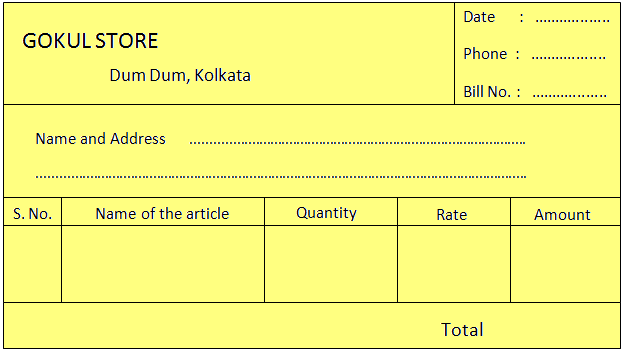Subscribe to our ▶️ YouTube channel 🔴 for the latest videos, updates, and tips.
What is Bills in Maths?
We will learn about bills and billing of different items.
Sometime we go to market to buy various items like potatoes, fruits, vegetables, clothes etc. in different quantity. The shopkeeper gives us articles and we make the payment to him of the total cost of these articles. The shopkeeper keeps a record of the articles we purchase.
The slip of paper on which a shopkeeper notes down the requirements of a customer or buyer and calculates the total cost of items purchased is called a BILL.
Here is your bill. The total amount has come to $ 199.50
The customer reads the bill carefully. He also checks the total amount shown in the bill.
In our daily life, we receive a variety of bills for example telephone bill, cooking gas bill, provisions bill etc.
Uses of Bill
1. A shopkeeper can keep a track on the day sales.
2. The customer can cross check the prices items purchased and their total cost.
3. In case of any problem, the customer can change the item easily by showing the bill.
Format of a Blank Bill
1. Rita from Sarad Bazar Delhi – 110006 bought the following items from Agarwal Provisions Store Sadar Bazar Delhi – 110006 on 06.05.2015.
(a) 5 kg rice at the rate of $ 30.00 per kg.
(b) 3 kg urad dal at the rate of $ 36.00 per kg
(c) 5 kg wheat flour at the rate of $ 9.00 per kg
(d) 2 litre mustard oil at the rate of $ 45.00 per litre
(e) 2 packets of surf at the rate of $ 30.00 per packet.
Prepare a bill for the above items.
Solution:
Preparing a Bill:
Check the steps:
(i) Write the name of the shop, its location, phone number, date of purchase of item.
(ii) Make 5 columns: Item number, name of the article, its quantity, rate of each article and the amount of the article.
(iii) Enter the name of item, rate and quantity in bill.
(iv) We can calculate the amount for each item by multiplying the rate by quantity.
(v) We find the total cost of item purchased.
Thus, the bill is prepared as under:
2. Check the correctness of the following bill:
Ron purchased some vegetables from ABC Store, G.t. Road, Aligarh. The bill given by store is given below:
Solution:
Checking the correctness of the bill:
1. Cost of 10 kg of potatoes @ $ 2.00 = 10 × 2 = $ 20.00
2. Cost of 5 kg of onion @ $ 3.00 = 5 × 3 = $ 15.00
3. Cost of 5 kg of beans @ $ 15.00 = 5 × 15 = $ 75.00
4. Cost of 10 kg of carrot @ $ 3.00 = 10 × 3 = $ 30.00
Total = $ 140.00
Therefore, the mistakes in the bill are:
(a) At S. No. 2, the correct amount is $ 15.00
(b) At S. No. 4, the correct amount is $ 30.00
(c) In total the correct amount is $ 140.00
5th Grade Math Problems
From What is Bills in Maths? to HOME PAGE
Didn't find what you were looking for? Or want to know more information about Math Only Math. Use this Google Search to find what you need.





New! Comments
Have your say about what you just read! Leave me a comment in the box below. Ask a Question or Answer a Question.